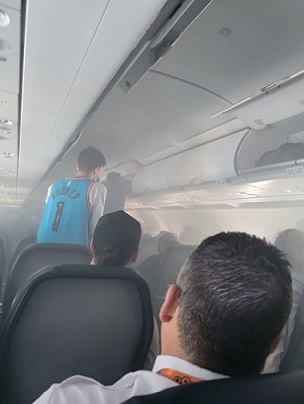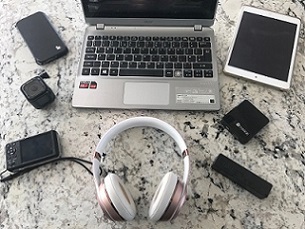 Toxic smoke spirals through a plane after a lithium battery went into thermal runaway
Toxic smoke spirals through a plane after a lithium battery went into thermal runaway
 A pilot holding an AvSax lithium battery fire mitigation bag
A pilot holding an AvSax lithium battery fire mitigation bag
 All these everyday electronic devices are powered by lithium batteries
All these everyday electronic devices are powered by lithium batteries
 AvSax save the need for passenger aircraft to divert and make emergency landings
AvSax save the need for passenger aircraft to divert and make emergency landings
Lithium batteries have caused fire incidents on board five planes in just one month and every time the overheating device was placed in a thermal containment bag.
All the incidents happened in American airspace or involved American aircraft and have been made public by the Federal Aviation Administration which regulates civil aviation in the USA – but other authorities around the world don’t reveal figures so the monthly statistics globally are likely to be far higher.
Four of the planes are operated by American Airlines but that’s purely coincidental. All carry lithium battery thermal containment bags which meant the problem was quickly sorted and the planes all then flew on to their final scheduled destinations with no-one hurt … and one hadn’t even taken off.
Some of the devices were even switched off which shows how potentially dangerous faulty lithium batteries can be.
This means there have been 460 verified incidents involving lithium batteries on aircraft between March 2006 and December 31, 2023, recorded by the Federal Aviation Administration.
Here are full details about the latest incidents which all happened in December 2023.
On December 1 during a Virgin Atlantic flight from Manchester to New York a passenger’s mobile phone began to overheat and a cabin crew member put it in a thermal containment bag.
On December 5 an American Airlines plane was taxiing for departure at Milan in Italy when a passenger’s portable battery pack began to overheat. A flight attendant put it in a thermal containment bag and the aircraft returned to the departure gate where the bag was taken off the plane.
On December 13 a passenger’s laptop began to overheat even though its power was off and it was stowed away on an American Airlines aircraft flying from Sacramento in California to Charlotte in North Carolina. A member of the cabin crew put it into a thermal containment bag for the rest of the flight.
On December 15 a passenger’s e-cigarette began to overheat in a carry-on bag on an American Airlines plane flying from Boston in Massachusetts to Los Angeles. It was placed in a thermal containment bag by a flight attendant.
On December 28 a passenger found a vape device in the lavatory on board an American Airlines flight from Miami in Florida to Phoenix in Arizona. The vape had become hot so the passenger immediately alerted the flight attendant who put it in a thermal containment bag.
Some airlines are still not equipped with thermal bags so have to divert and make emergency landings when lithium incidents happen which can prove very disruptive for the passengers and costly for the airline companies.
The latest incident involved a Royal Air Philippines plane flying from Caticlan in the Philippines to Shanghai in China on February 19, 2024. It diverted to Hong Kong after a passenger’s power bank battery went into thermal runaway, sending smoke spiralling through the cabin.
Lithium batteries power all our everyday electronic devices such as mobile phones, laptops, iPads, vapes and e-cigarettes.
When a lithium battery overheats it goes into a chemical process called thermal runaway and when this happens one cell in a battery can produce enough heat – up to 900°C (1652°F) – to cause adjacent cells to overheat. This can cause a lithium battery fire to flare repeatedly and they are then very difficult to put out which is why fire mitigation bags are so important, especially in the confined space of aircraft passenger cabins.
The ever increasing number of lithium battery incidents on aircraft means that many airline operators now have thermal mitigation bags on board to deal swiftly and effectively with the problem before anyone is hurt or the aircraft is damaged.
The most widely used by far is the AvSax which is now on almost 17,000 planes operated by around 100 airlines.
The AvSax won the Queen’s Award for Enterprise for its innovation in the UK – the highest award any business can achieve.
The reason it’s so popular among airlines is that it continually cools the overheating device while containing it.
The UK’s regulatory organisation the Civil Aviation Authority says: “Since the development of the International Civil Aviation Organization guidance on dealing with an in-flight battery fire, new products designed for use in response to lithium battery thermal runaway events have become available.
“Products which provide both a cooling and containment capability are typically more aligned to the existing ICAO guidance as when used they are filled with water or other non-flammable liquid to act as a cooling agent.
“After knocking down flames it could conceivably take just a couple of seconds for a personal electronic device to be placed inside a containment bag, allowing it to be moved to a place of safety.
“Passengers could then return to their seats, mitigating potential unrelated safety hazards such as injury in the case of severe turbulence. Equally, the effect on flight crew in carrying out their duties following an event on the flight deck would be minimised.”
For more information on AvSax go to www.avsax.com